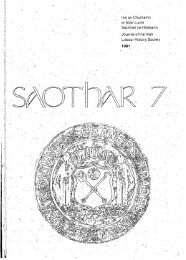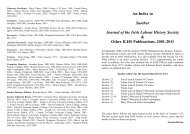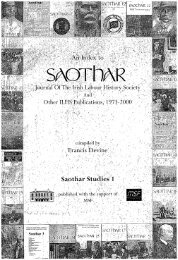46 SAOTHAR 13of Irish poverty into the English anti-poverty ideology, and naturally rendered any practical assistanceimpossible to administer. War in Ireland was almost always interpreted by the government as rebellion;in such cases the social misery which accompanied defeat was regarded as a form of natural justice notto be mitigated by human agencies. In more peaceful times, and in the absence of settlement laws orother regulatory systems, mendicancy developed almost to the status of an underworld profession inIreland, wondered at by disgusted tourists and connived at by more prosperous locals. Charity,unorganised (except in times of unusual crisis) and probably part of the landlord/tenant deferencerelationship, must have been one of the principal features of Irish rural life in the eighteenth centurysince, despite the rising population, the problem did not become uncontrollable until after 1800.The problematic nature of poverty in Ireland first became apparent in the cities, and it was there thatlong-term attitudes were to develop. Society in both kingdoms had traditionally been less concernedwith the reasons why 'vagabonds' wandered and were idle than with protecting citizens from theirdepredations. Even before Tudor times society protected itself by incarcerating the vagabonds. Thiscrude institutional solution was a means of containing the problem, since the worst aspects ofdeprivation for the vagabond disappeared once he was jailed, however otherwise unpleasant theexperience might prove. The ad-hoc relief of poor persons on the streets through almsgiving in someways compared unfavourably with the sanctuary and regularity of a prison existence. However, manybeggars, especially in Ireland, drew a sharp distinction between themselves and petty criminals. It islikely that the former had a clear view of their position and rights in society, and their rejection of theworkhouses in the period after 1838 may have stemmed from this as much as from any discomfortwithin the houses. 2 Aside from a somewhat superficial humanitarianism, it is probable that pressurefrom a harassed and importuned public lay behind the establishment of institutions in Dublin, Cork andBelfast in the early eighteenth century known variously as workhouses or houses of industry. Thesewere built to cope with beggars who, in the expanding urban environment, proliferated beyond the pointof ordinary social management or even public endurance. The determination of the city-dwellers toconiain the problem institutionally was a sign of failure rather than the solution the houses wereintended to represent. For the most part the ethic of mendicancy reasserted itself and respectablebeggars refused, except under duress, to be identified with criminals. Exceptionally cold weather,famine or other irregular disasters would periodically fill the houses, but for the most part the beggarsremained on the street. In virtually every street scene on every contemporary print and painting fromMalton to Petrie the beggar has his corner, a representation of reality as much as an artistic convention.At their worst the beggars of the eighteenth century were a nuisance. But in an age of poor hygiene,infrequent street repair, building and planning irregularities, and general congestion, it was easy andinevitable that urban-dwellers should eventually interpret nuisance as threat and to respond by labellingitas aminorcrime. The poorrelief institutions of the eighteenth century which aimed at the containmentof general adult mendicancy all failed in their objectives, less because of the horrific irregularities intheir operation than because they represented the losing side in a conflict of world-views, ethics, andideology. They lost because eighteenth-century society lacked the necessary coercive devices to enablethem to succeed. The purveyors of the New Poor Law in Ireland later won a partial victory because theyhad been able to identify the immediate reasons for the defeat of the Georgian institutions. Their victorywas only partial, however, because they_ failed to detect the underlying causes of that earlier defeat.With industrialisation came the beginning ofthe end of pre-industrial society in England. Thepurityof the deferential relationship in Ireland had always been sullied somewhat by historical events, and thedegree to which it prevailed remains, in the absence of proper investigation, a matter for speculation.The souring of deference in England, together with the desperate conditions at the close of theNapoleonic War, facilitated the spread of Malthusianism and the fear of social anarchy. In Ireland classrelations had been affected more by political events than by the concurrent social problems during thesame period. But in general the non-arrival of an industrial revolution on the British scale saved Irelandfrom the precise type of social threat which seemed to hang over early regency England. Ireland did" not have a centrally or locally-administered poor-relief system which could be supplemented, adapted,
••• .".'. >. '~"ESSA YS IN REVIEW 47or otherwise altered to meet the requirements of a collapsing social framework. Thus the Irish poorescaped the corrosive effects of the Speenhamland system and clung to the vestiges of a shaken butpartiaUy-intact social network. The final threat to Irish deference came not from race~memory orpolitics or industrialisation but from the financial decrepitude of Irish landowners and the presence ofan over-large peasant population. I use the word 'presence' advisedly since historians have still todecide whether the population of pre-famine Ireland was increasing or decreasing.British interesi in solving their own poor-relief problems spilled over into Ireland only when Irishpoverty itself had begun seriously to spill into Britain. The economic crisis in Ireland from 1815onwards caused many Irish landowners to rationalise their estate-management in order to improve, orin some cases to bring about their viability: The resultant clearances fused with concurrent growth inthe efficiency of steamships, and large numbers ofIrish paupers suddenly became an immediate Britishproblem. 3 Parliamentary enquiries into the state of the Irish lower orders coincided with the aftermathsof two earlier famines of the nineteenth century, and as barometers of 'normal' poverty they aretherefore of limited value. Certainly the enquiries led to no immediate attempt at a solution. Thegovernment had responded to the two famines by setting up short-term ad hoc relief committees, oftenlocally administered. Events later in the century would show this to be a pattern fraught with fatalconsequences. In the first third of the century the connection between inadequate estate-managementand lower-class poverty had become obvious, but uncertainty prevailed for most of the Victorian periodwith regard to a solution. In the event, discussions on a compulsory poor law for Ireland arose less froma desire to assist the poor than from a conviction that Irish property-owners should pay for Irish poverty;a law of settlement was aimed at rather than the relief of the poor.And so it was that the British and Irish authorities spent part of the 1830s in examining the variousoptions and approaches available regarding a poor law in the Irish environment. The report of a Select. Committee in 1830, valuable in its wealth of information but lacking in conclusiveness, led to a fullscaleRoyal Commission headed by the Archbishop of Dublin, Richard Whately, and rather weightedwith concerned Catholics. In the course of three extensive reports the commissioners rejected theworkhouse concept as inappropriate to a non-industrialised environment. The state ofIrish poverty wassuch that any outdoor relief system would, they believed, be ruinous. In a positive vein thecommissioners suggested emigration schemes, land reclamation and public works, all of which wouldnecessitate some degree of direct government intervention. 4 The commission had in fact cut its wayto some of the root-causes of poverty in Ireland and its recommendations were mechanical (thoughoccasionally imaginative) responses to those causes. The government's inevitable rejection of thecommissioners' proposals perhaps was rooted less in politics and economic theory than in a traditionalfailure to come to terms with the Irish environment.In the administrative sense the New Poor Law seemed a promising solution; the innovative nationalschool system had after all been successful in placing education where there had previously been none.B ut the replacement of poverty by industry and thrift proved less simple than had been anticipated. Thenew workhouses contained the sick, the mad, and children as well as able-bodied paupers. The poorlaw rhetoric echoed the belief that workhouse inmates were a new type of criminal being punished fortheir social inadequacies. Burke's account of the poor law in Ireland is the first full-length modemtreatment. One of its most interesting features is the tracing ofthe workhouse's progress from its cruderole as a social melting-pot in 1838 to its emergence as a surprisingly versatile health service later inthe century. Famine, administrative contradictions, changing social attitudes and other factors whichbrought about the expansion of the workhouse's facilities are charted by B urke with considerable skill.Despite the book's broad chronological expanse it is a work of impressive depth and is marred only bythe odd choice of the South Dublin Union as a 'typical' example of workhouse practice.One obvious historical conclusion to be drawn from Burke's researches (though not one spelt outin her book) is that the early poor law experience in Ireland represented the nadir of Irish poor reliefhistory. The workhouses when they opened signalled the absorption into the poor law system, andtherefore the closure, of several of the institutions which had until then catered for special categories
- Page 1 and 2: JOURNAL OF THE IRISH LABOUR HISTORY
- Page 3 and 4: ContentsPageEditorial: Labour Histo
- Page 5 and 6: EDITORIAL 3freedom to participate i
- Page 7 and 8: CorrespondenceThe Irish Labour Part
- Page 9 and 10: ; ~ ; ,The Decline and Fall of Donn
- Page 11 and 12: THE DECLINE AND FALL OF DONNYBROOK
- Page 13 and 14: THE DECLINE AND FALL OF DONNYBROOK
- Page 15 and 16: ·' THE DECLINE AND FALL OF DONNYBR
- Page 17 and 18: THE DECLINE AND FALL OF DONNYBROOK
- Page 19 and 20: THE DECLINE AND FALL OF DONNYBROOK
- Page 21 and 22: THE DECLINE AND FALL OF DONNYBROOK
- Page 23 and 24: THE DECLINE AND FALL OF DONNYBROOK
- Page 25 and 26: ,'-,;-''''.A PASSAGE TO BRITAIN 23C
- Page 27 and 28: A PASSAGE TO BRITAIN 25only in the
- Page 29 and 30: A PASSAGE TO BRITAIN 27clothing._De
- Page 31 and 32: A PASSAGE TO BRITAIN 29established
- Page 33 and 34: ;:-.",.- .. .", ...... '.:. '
- Page 35 and 36: LOUIE BENNETI 33feminist movement w
- Page 37 and 38: :... ~: ."
- Page 39 and 40: -.- '.LOUlE BENNETT 37While there i
- Page 41 and 42: LOUIE ~ENNEIT 39Xl's encyclical Qua
- Page 43 and 44: LOUIE BENNEIT 41Bennett's own relat
- Page 45 and 46: LODIE BENNETT 43109; IWWU resolutio
- Page 47: Essays in ReviewCosherers, Wanderer
- Page 51 and 52: ESSAYS IN REVIEW 49ConnolIy:Myth an
- Page 53 and 54: ESSAYS IN ~EVIEW 51tion' in the Int
- Page 55 and 56: ESSAYS IN REVIEW53International:'I
- Page 57 and 58: REVIEWScontroversy is real history.
- Page 59 and 60: REVIEWSJoe Monks was among the earl
- Page 61 and 62: REVIEWSnolly-Column Song','Proudly
- Page 63 and 64: REVIEWSresulting from the arrival o
- Page 65 and 66: REVIEWS,63the book by means of an a
- Page 67 and 68: REVIEWSlogue, it is hardly surprisi
- Page 69 and 70: The Team For All Workers ...CULIAIB
- Page 71 and 72: ESSAYS 69mission and moral refonn.l
- Page 73 and 74: .. ...... ~.~ -~ .'- '.ESSAYS. 71fr
- Page 75 and 76: ESSAYS 73claimed authority but whic
- Page 77 and 78: ESSAYS 75provided the basis for soc
- Page 79 and 80: ESSAYS 779. For comparisons see E.T
- Page 81 and 82: ESSAYS 7952. Annals of Christ Churc
- Page 83 and 84: ESSAYS' 81Fianna Fail and the Worki
- Page 85 and 86: ESSAYS 83Eireann in 1925 visibly di
- Page 87 and 88: ESSAYS 85recognition of the impract
- Page 89 and 90: ESSAYS 871970, it created the condi
- Page 91 and 92: ESSAYS89The Irish Immigrants' Contr
- Page 93 and 94: ESSAYS" 91Although anti -Catholic p
- Page 95 and 96: ESSAYS 93McCowie played a key role
- Page 97 and 98: :. -,,'.' ',. .~.,:.ESSAYS 95Althou
- Page 99 and 100:
ESSAYS 97young girl of their own ba
- Page 101 and 102:
SourcesIrish Labour History Society
- Page 103 and 104:
SOURCES 101INovember, 1971 to no. 1
- Page 105 and 106:
SOURCES 103would claim credit for t
- Page 107 and 108:
SOURCES105Sources for Irish Labour
- Page 109 and 110:
SOURCES 107NorthWest Archives and L
- Page 111 and 112:
SOURCES 109In 1966 the Finnish gove
- Page 113 and 114:
TURNINGANEWLEAFThe CPSSUis the larg
- Page 115 and 116:
REMINISCENCE 113us due to my politi
- Page 117 and 118:
REMINISCENCE 115when Jim was presen
- Page 119 and 120:
REMINISCENCE 117of Dail Eireann. 17
- Page 121 and 122:
REMINISCENCE 119NotesThe above arti
- Page 123 and 124:
DOCUMENT STUDY 121James Connolly in
- Page 125 and 126:
DOCUMENT STUDY123SOCIAL DEMOCRATIC
- Page 127 and 128:
DOCUMENT STUDY 125proletariat of th
- Page 129 and 130:
DOCUMENT STUDY 127the support of Je
- Page 131 and 132:
DOCUMENT STUDY 12926. The Workers'
- Page 133 and 134:
131BibliographyA Bibliography of Ir
- Page 135 and 136:
BIBLIOGRAPHY 133Compton, P.A. Demog
- Page 137 and 138:
BIBLIOGRAPHY 135Levine, I. and Madd
- Page 139 and 140:
BIBLIOGRAPHY 137Turner, M. 'Towards
- Page 141 and 142:
BIBLIOGRAPHY 1394. Land and Agricul
- Page 143 and 144:
BIBLIOGRAPHY 141Clogher Record12 (2
- Page 145 and 146:
BIBLIOGRAPHY 143Political Research
- Page 147 and 148:
BIBLIOGRAPHY 145Pres, 1987.O'Brien,
- Page 149 and 150:
147Notes on Contributorsf onathanBe
- Page 151 and 152:
1901: Ireland's first general union
- Page 153 and 154:
ELECTRICAL TRADES UNION .Establishe





